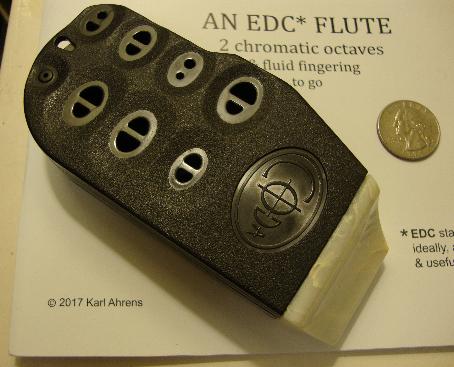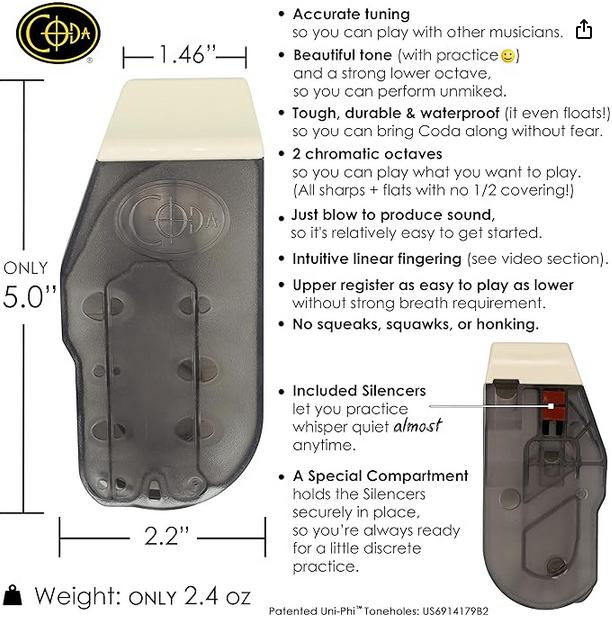by Howard Fosdick © FolkFluteWorld.com.
What if you could reimagine the flute? What would you magically create? You might come up with something like the Coda EDC. It's a newly patented flute design that plays a full two-octave range.
The Coda is technically a vessel flute -- what most people call an ocarina. Air resonates within its enclosed chambers. This differs from the recorder and the concert flute, which are essentially pipes with fingering holes and open ends.
The big problem with vessel flutes has always been that their range is limited. Most play only up to 10 or 13 whole notes (with all sharps and flats between).
There have been many work-arounds to this limitation. For example, "dual-chamber ocarinas" where you move your fingers to a different set of holes to play in either of two octaves. But these feel awkward to many musicians and require specialized skill.
The Coda flute provides a full two-octave range without requiring that you move your hand to a different finger holes to play in each octave. Instead, you merely blow into the breath-hole for the octave you want.
Other Coda innovations include its unique silencers for quiet play, and a fitted belt clip for convenient carry. And then there is its highly durable, yet lightweight design. You can carry this thing anywhere. It's indestructible and it doesn't need a case.
The Coda is the brainchild of Karl Ahrens, who you may know as the founder of Mountain Ocarinas. MO inline ocarinas have garnered many positive reviews over the years. The Coda EDC is Ahrens' futuristic flute, an innovative portable oc with a full two octave chromatic range.
This review tells you all about the Coda EDC.

The Coda EDC Flute (courtesy of Karl Ahrens). See more photos here.
The Basics
The Coda presently retails for about $59.95 plus shipping at the Coda EDC website (all prices subject to change). Buy two or more and shipping is free within the U.S. You can pay with Paypal, Google Pay, or Shop Pay. They don't accept credit cards, debit cards, or checks.
Or you can buy the Coda at Amazon.
Codas come in two color schemes: all black, or black with ivory mouthpiece. They're made of a high-quality instrumental plastic. They're lightweight, yet their tough plastic means they can take some knocks without damage. This makes them way more portable than ceramic ocarinas and even more robust than most plastic ones.
An optional $5 clip allows you to clip the instrument to your belt or waistband for easy carrying. The oc also has a small lanyard hole for those who prefer to carry it via a neckstring (not included). In either case, your flute arrives with a nice cloth carry-bag with drawstring.
The Coda is small enough -- and tough enough -- that I've found it convenient just to tuck it into my pants pocket. Its smooth, rounded corners make this comfortable. And it only weighs 2.4 ounces! Karl Ahrens calls his invention the "EDC" or "EveryDay Carry" flute and touts its portability. I agree. I look forward to taking my Coda camping. Unlike my ceramic ocarinas and wood recorders, I won't have to worry if it gets wet or takes a knock.
Along with the Coda itself, you'll receive two large fold-out sheets to help you get started. They diagram the parts of the instrument and illustrate proper finger placement. They include a fingering chart and tips to get you playing right off. And you'll receive several quick-reference cards and product stickers.
When bought directly from MO, a fifty page songbook shipped free with the product. This is not some little pamphlet, but rather a full-size 8.5" by 11" softbound. It contains about 80 songs, half of which were composed by famed Irish composer O'Carolan (1670-1738).
Many of the tunes are provided in two or three different keys. This gives you practice material for the Coda's full range. It's also helpful in learning how to finger sharps and flats. I enjoy learning a tune in the simplest key and then improving my skills by playing it again in a more challenging key.
If you buy from Amazon, I don't believe you get this free song book bundled with the EDC flute. But as I'll mention below, you can download a ton of free sheeet music from the Mountain Ocarinas website.
Impressions
It takes a couple days to get used to the feel of any new musical instrument. Once you do, you'll find the Coda rests comfortably in your hands. The flute is very lightweight compared to clay ocarinas. You won't get tired holding it.
It's easy to hit all the notes with this oc. All sound strong and true.
To my surprise, the breath requirement is consistent across the instrument's entire range. You needn't blow harder to hit the highest notes accurately. Unlike like some oc's, these sound softly enough that you'll enjoy playing in the upper register.
I'd like to emphasize this point because musicians often complain about the high notes in "rising breath" ocarinas. I own an excellent oc I never play because you have to blow the high notes so loudly to keep them in tune that it becomes unpleasant to my ears. (Not to mention how it disturbs the neighbors.) The Coda's consistent-breath design solves this problem.
Fingering the Coda is easy because it's the same in both octaves. Just take a look at the fingering chart. You cover the same finger holes regardless of the octave in which you play.
As with any dual-chamber oc, you have to get used to switching breath-holes. Thus, the initial challenge for beginners is seamless transition between octaves. I found it took some practice to master this, mainly because you have be precise to keep notes across chambers in tune.
Coda makes octave transitions as easy as possible by overlap between the chambers. That is, you can play the three intermediate notes of the instrument from either breath chamber. I found this helpful in learning to play, because it gives you flexibility over which chamber to choose.
While the fingering for whole notes is the exact same across both chambers, the fingering for sharps and flats varies a bit. You have to learn chromatics appropriate to the chamber you're blowing. This is where some learning curve comes in that's unique to this instrument. The song book that comes with the product is helpful in learning this.
Another thing to get used to about this oc: you'll be covering double-holes with your fingers, so you need to get the feel of the instrument. Like most the other adjustments I've mentioned, this is pretty simple to accomplish once you've played enough to get good hand-memory for the instrument.
I love the sound of this flute. It's pure and distinctive: the inline design gives it a different timbre than transverse ocarinas. I really like that the Coda adds a unique voice to my small ocarina collection.
Here's how the Coda sounds at Youtube:
One common complaint about ocarinas is that they're too loud to play around roommates or housemates. Coda offers little specially-designed silencers that easily insert to quiet the instrument.
Of course, you don't get the same lovely sound as without the silencers, but they're intended for quiet practice. The Coda is cleverly designed so that the instrument itself carries the silencers when you're not using them. At various times, silencers have either been included with the instrument at no extra charge, or available separately at $9.95 for two sets. You'll have to look to see what the deal is on this when you buy.
If you've never played a small plastic instrument before, be aware that moisture builds up inside. Just give it a quick hard blow or suck to reduce condensation and keep the sound strong. You can wash the instrument by dipping it in warm water and swishing it around.
Free Resources
A huge benefit to the Coda is all the free resources it offers. You needn't buy anything beyond the instrument itself. Here are some freebies to get you started:
- Beginning tips -- tutorials, videos, more
- Self-learning music curriculum
- Facebook page
- Sheet music -- Japanese folk songs
- Sheet music -- Christmas carols
- Coda Youtube channel
- Other Coda Youtube videos
- Youtube Coda reviews here and here
Wow! You don't need to buy a thing beyond the Coda itself. Everything you need to learn this instrument and play it is available online for free. I especially like that they provide lots of sheet music for free downloading. How nice is that?
A New Kind of Flute
The Coda offers a greater musical range than common single-chamber ocarinas. It represents the first real alternative design to multi-chamber ocarinas I've ever seen.
Its thoughtful design ensures that it's still pretty easy to play. Plus, it's lightweight, portable, and sounds lovely.
Its unique innovations include custom-fitted silencers and a belt clip. And it comes with a ton of free resources to back it up.
Do I recommend it? Definitely.
**** SUMMARY ****
Style: Dual-chamber inlineMaterial: High-grade instrumental plastic
Where to Buy: Coda EDC website or Amazon
Pitch: C5 to C7
Chamber Pitches: Lower is C5 to D6, Upper is B5 to C7
Chromatics: Plays all sharps and flats
Dimensions: 5" long, 2.33" wide (maximum), 1.25" high (maximum)
Weight: 2.4 ounces
Cost: $59.95 plus shipping. Free shipping within U.S. for two or more. (All prices subject to change.)
Options: Belt clip for $5.00, Silencers at $9.95 for two sets. (NOTE: some versions bundle one set of silencers with your purchase of the instrument.)
Songbook: Some packages bundle a free 50-page songbook with the ocarina, other versions require you to buy it separately.

(courtesy of Karl Ahrens)